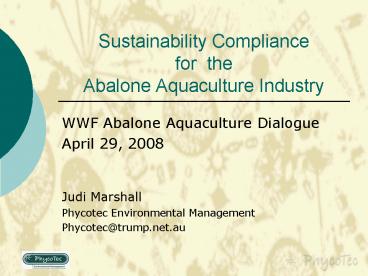Sustainability Compliance for the Abalone Aquaculture Industry - PowerPoint PPT Presentation
1 / 20
Title: Sustainability Compliance for the Abalone Aquaculture Industry
1
Sustainability Compliance for the Abalone
Aquaculture Industry
- WWF Abalone Aquaculture Dialogue
- April 29, 2008
- Judi Marshall
- Phycotec Environmental Management
- Phycotec_at_trump.net.au
2
ESD ComplianceObjective To develop an EMS
Framework with template documents based on the
National ESD FrameworkFor Aquaculture
3
Outcomes from the Project
- Strategically assessed risks of the Tasmanian
Industry to the environment. - Strategically assessed risks to the Tasmanian
Industry from natural, social and economic
environment. - Prioritised actions to mitigate moderate and high
risks - Implementation of Environmental Management
Systems (EMS) into 80 of the Tasmanian Industry
4
Abalone Industry Risk Assessment (x75)
- gtModerate Risks
- Climate change
- Disease
- Markets
- LUPAA on Water Quality
5
Tasmanian EMS Framework
- ESD Requirements validation must include
- Definitive terms
- Relevant, scientifically robust, and peer
reviewed information - Balanced arguments
- Be acceptable to industry and regulators
6
Whole of State Issues (Environmental)
7
Regional Issues (Environmental)
8
Social Economic Issues
- All assessed as low on available information
- Very little data to do assessments
- National Aquaculture Council currently addressing
the identification of relevant social and
economic indicators for the aquaculture sector.
AAGA is a pilot group in this FRDC funded project.
9
External Impacts of the Environment
10
External Impacts - Disease
11
Facility Issues
- Hydrocarbon storage
- Chemical storage
- Lack of SOP
- Biosecurity SOPs
- Energy efficiencies
- EMS provides useful bench marks
12
External Perceptions
- Visual
- Water quality
- Odour
- Noise
- Public amenity
- Need for benchmarking
13
Reflections on the Tasmanian project An extract
from the final report
- Learnings
- Needs to be credible
- Have buy-on from majority
- Robust for scrutiny
- The picture is bigger than the individual
facility - Value
- Reporting mechanism
- A tool to meet compliance regulations
- Allows industry to implement EMS easily
effectively - Concerns
- Not adopted by all failure of penetration
- Risk assessments sometimes subjective ie
divergence of views - Need for independent audits for legitimacy
14
(No Transcript)
15
Nationally - Australian Abalone Growers
Association (AAGA)
- Agreement from all state regulators on risks for
each aspects - Streamline state industry requirements into a
national framework - Self management tool at national level
- A commercial tool to implement EMS as well as
tool to use to counteract the regulators /NGOs
when issues arise.
Objectives Have farm managers recognise their
regulatory requirements
16
Alignment of ESD reporting to FAO Guidelines for
Aquaculture Certification
- 7. Minimum substantive requirements and criteria
- 7.3 Social issues
- Achievable but requires verified data
- 7.4 Environmental issues
- All aspects covered by ESD Framework
- Needs improvement on carbon footprint reporting
- Requires industry baselines
17
Alignment of ESD reporting to FAO Guidelines for
Aquaculture Certification
- 7. Minimum substantive requirements and criteria
- 7.5 Food Safety and Quality
- More detail would need to be provided in ESD
reporting in relation to - Traceability
- Food hygiene practices
- 7.4 Animal Health and Welfare
- Requires more comprehensive reporting
18
Document structure
Australian Abalone Growers
National
State (Regional)
Facility
Environmental
Environmental
Environmental
Socio Economic
Socio Economic
Indigenous
Governance
Governance
External
19
Processes
- Listen to your stakeholders
- Create a culture of dialogue based on fact from
verified data - Demonstrate transparency
- Ensure responses are based on fact not conjecture
20
- Judi Marshall
- Developing Sustainable Industries
- Phycotec Environmental Management
- Phycotec_at_trump.net.au
- Ph 0438 589 955

